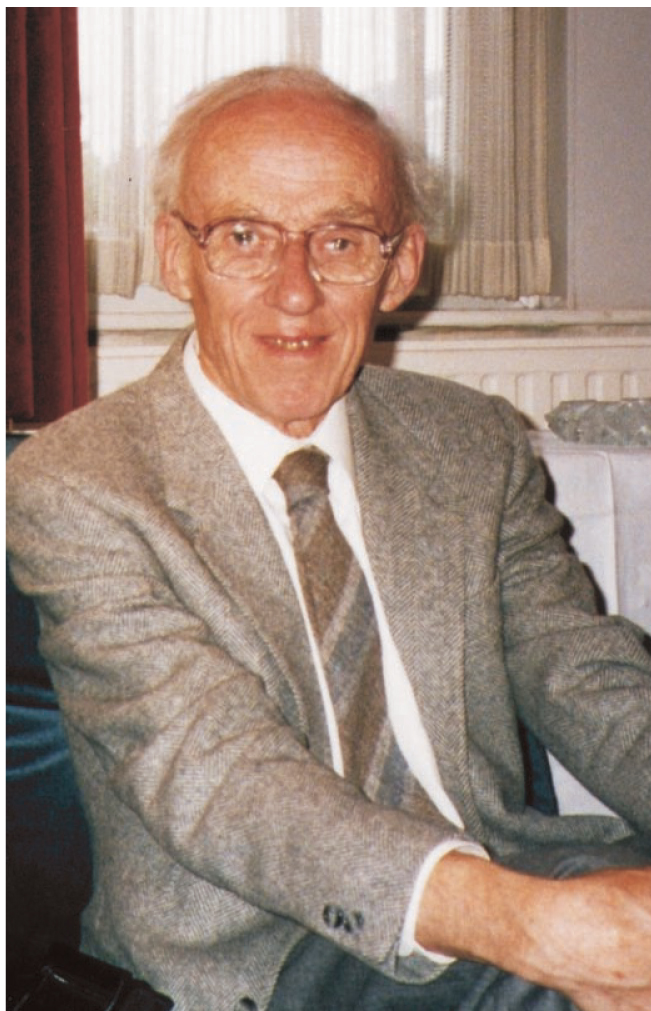Alexander Rawson Stokes
DOI: 10.1063/1.1650080
Alexander Rawson Stokes was closely associated with one of the most important scientific discoveries of the 20th century, namely the discovery of the double helix structure of DNA by James Watson and Francis Crick. Alec died of cancer on 6 February 2003 in Welwyn Garden City, England. It is sad that he missed the many celebrations of the 50th anniversary of the double helix to which he had been invited.
Alec was born on 27 June 1919 in Macclesfield, England. He was educated at the Warehousemen and Clerks School (now the Cheadle Hume School) in Cheadle Hume and at Trinity College, University of Cambridge, where he was graduated in 1940 with a BA in natural sciences. He then became a demonstrator in electricity at the University of Cambridge and worked in the Cavendish Laboratory as a research student in x-ray crystallography. He received his PhD from Cambridge in 1944; his doctoral thesis, “Imperfect Crystals,” was done under the supervision of Lawrence Bragg.
The 1940s was a very productive period for Alec, who made important contributions to a number of x-ray diffraction studies. Of particular importance was his contribution to the analysis of x-ray diffraction line broadening due to stress and particle size and, with Bragg, his work in developing the “Fly’s Eye” as one of the earliest techniques using optical diffraction to assist in the solution of x-ray diffraction structure analysis.
Alec was appointed lecturer in physics at the Royal Holloway College, London, in 1945. Two years later, John Randall recruited him to King’s College, University of London. Randall had set up a biophysics unit within the King’s Wheatstone Physics Laboratory, where biologists and biochemists worked with physicists.
When I went for an interview to be a postdoc at King’s in 1952, Randall introduced me to Maurice Wilkins (who shared the 1962 Nobel Prize in Physiology or Medicine with Crick and Watson). Wilkins subsequently introduced me to Alec and Rosalind Franklin. I knew of Alec’s work on line broadening, which was relevant to my PhD studies on the effect of stress on metals, and I was apprehensive that he would ask me awkward questions! However, my worries on that account were unfounded. I met with a gentle and courteous person, and as I found later, if he had one characteristic above all others, it was extreme modesty.
In 1950, Wilkins obtained a preparation of calf thymus DNA from Rudolf Signer of Bern, Switzerland. From gels of that material, he was able to draw thin, uniform fibers that showed sharp extinction between crossed polarizers. With Raymond Gosling, Wilkins obtained from those fibers x-ray diffraction patterns that showed a high degree of crystallinity. When Alec was shown photographs of the patterns, he suggested that they could be due to a helical structure. Alec was thus the first person to suggest, on the basis of experimental data, that DNA had a helical structure.
Wilkins asked Alec if he could work out what sort of x-ray pattern would be given by a helical structure. Alec mulled over the problem on the train home and realized that the Fourier analysis that was needed to solve the problem involved Bessel functions; he came in the next day with a diagram of Bessel functions that became known as Waves at Bessel-on-Sea. Alec later said, “I was fortunate in that I had met Bessel functions before, in different contexts, so I knew what sort of creatures they were and I was not at all scared of them!” One such context, pointed out by Archibald Howie, was in A. J. C. Wilson’s analysis of “Diffraction by a Screw Dislocation,” published in 1949 in Research, in which Wilson acknowledged Alec for criticism and suggestions. Wilson had been Alec’s collaborator in some of the x-ray diffraction line-broadening analyses. Alec did not publish his helical diffraction theory; rather, the theory was published in Acta Crystallographica in 1952 in an independent derivation by William Cochran, Crick, and Vladimir Vand.
When Wilkins and Alec compared the helical theory with the DNA diffraction patterns, they agreed that there was something very helixlike about the patterns. But the question was, What kind of helix? Watson and Crick answered that question when they proposed their double helix model of DNA.
When Watson and Crick announced their discovery, there were two accompanying papers from King’s College that gave experimental support for the model. One was by Wilkins, Stokes, and myself, and the other was by Franklin and Gosling. All three articles appeared in Nature on 25 April 1953.
Alec contributed to further DNA studies and used optical diffraction to analyze x-ray fiber diffraction patterns of DNA and other polymer structures. He brought his exceptional mathematical skills and understanding of diffraction phenomena to analyze a number of other problems of biophysical interest, including image formation in optical microscopy, light scattering from randomly oriented prismatic structures, and x-ray scattering by long chain molecules. Among Alec’s publications are two books: Theory of the Optical Properties of Inhomogeneous Materials (E. & F. N. Spon, 1963) and, with C. J. Smith, The Principles of Atomic and Nuclear Physics (Edward Arnold, 1972).
An inspiring and sympathetic teacher, Alec was also a longtime member of the King’s College Board of Studies in Physics and was its chairman for a number of years. However, he was not enthusiastic about administrative duties. He retired as senior lecturer in 1982.
In September 1993, a plaque was unveiled at King’s College that commemorated the x-ray diffraction studies of DNA carried out in 1953 at the university. The names on the plaque are Franklin, Gosling, Stokes, Wilkins, and Wilson.
Alec enjoyed many activities outside science. He had a keen interest in music, played the piano, and participated in choral singing. He was also an elder in his local Free Church (Presbyterian Church) in Welwyn Garden City.

Alexander Rawson Stokes

More about the Authors
Herbert R. Wilson. University of Stirling, Stirling, Scotland, UK .
